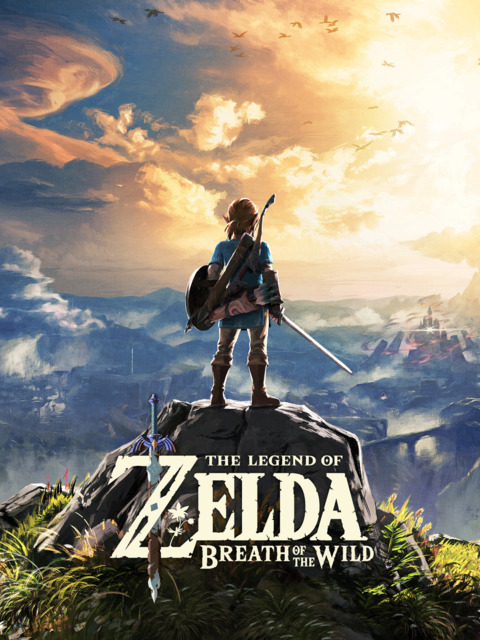While reinventing the series, Breath Of The Wild also re-establishes new standards for Zelda
The childlike joy that's found in the basic movement and exploration of The Legend of Zelda: Breath of the Wild even within the first five minutes was a pretty good indication that this was going to be a great time. More than fifty hours later (and that's even coming in a little lean), that early feeling was well-founded. Previous core console entries in the franchise had - while never being bad - left the entire Zelda franchise in a state of malaise and stagnation. Something had to change about the fundamentals of the series and the progression from start to finish in the game, or this was just going to be 'another Zelda' when another Zelda may not have cut it. For a company that's made some wacky decision in it's time, it had looked for a decade like this was something Nintendo were inexplicably incapable of innovating around. Turns out we were wrong, and everyone is the better for it.
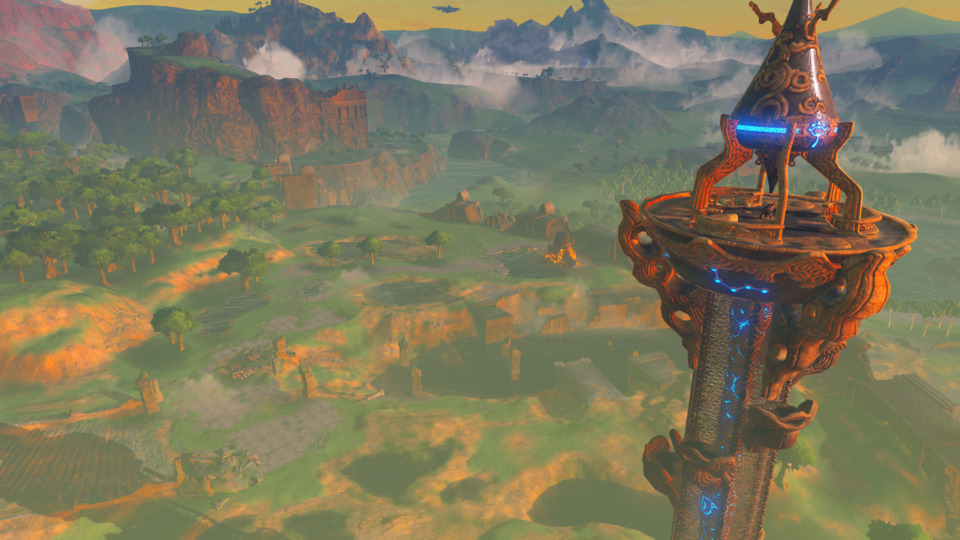
There had been some experimentation with openness in 2013's A Link Between Worlds with it's item rental ideas that allowed for more freedom in the order you tackled the game's dungeons, but this pales in comparison to the sea change of Breath of the Wild. Woken up from his one hundred year slumber, Link is tasked with visiting four shrines by an old wanderer in order to get a glider to leave the plateau he finds himself on. Soon revealed to be the spirit of the previous king of Hyrule, Link is informed of his original mission from a century ago to fight the evil force of nature that is Calamity Ganon, and is directed towards the still peaceful town of Kakariko Village. That about sums up the first thirty minutes of Breath of the Wild. After you glide off the plateau and into greater Hyrule, the world is your oyster.
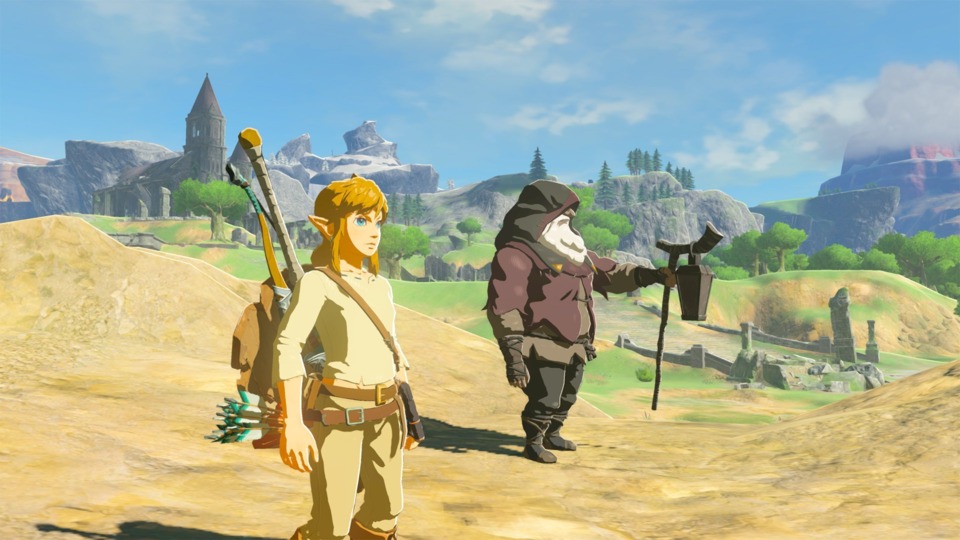
As eye-roll inducing as it is, the idea of "Do you see that mountain? You can go there" has never felt more viable than here. As soon as you're free and set out into the open world, there's almost nothing that stands in your way of going in any direction you choose. There are still obstacles that need to be overcome, but you're no longer gated in progress by not having the right arbitrary item to navigate terrain (remember the spinner from Twilight Princess?), instead only by your own abilities... and maybe your stamina. In addition to a dedicated jump button, one of the most substantial new features is a stamina gauge that depletes when performing certain actions like running or climbing. And you'll be doing a lot of climbing, the other most noteworthy new feature. Nearly every surface you encounter can be scaled allowing for far more verticality than in any previous games.
Movement isn't the only thing that's new and improved, combat feels more fluid as well. Switching from melee weapons to bows is as easy as the pull of a trigger or press of a button, and blocking with your shield or simply running to dodge allows for more easy to use defensive capabilities than ever before. The biggest change, however, comes in the form of enemy loot and weapons. Gone are the days of one equipped sword, shield, and bow, replaced with a system where you are constantly finding new equipment in the world and from fallen enemies to use as your own until you're done with them (or throw them, as there is now a button to make any weapon a projectile). This new system is kept in check with a weapon durability system where equipment will degrade and break over time, creating a need for more in a constant loop. Your stores of weapons, shields, and bows can be upgraded one slot at a time by finding the seemingly thousands of Korok seeds in the world and delivering them to the large Korok merchant of sorts wandering around the world for more equipment space. While some may find this lack of permanence in your equipment to be a hassle, I was never without enough weapons to go on, and liked having to switch up my style from time to time as I found weapons that had different properties and abilities. In fact, more often than not, I was finding more equipment than I was capable of carrying, and had to throw away things to make room for the new swords, spears, clubs, etc. that I was finding.
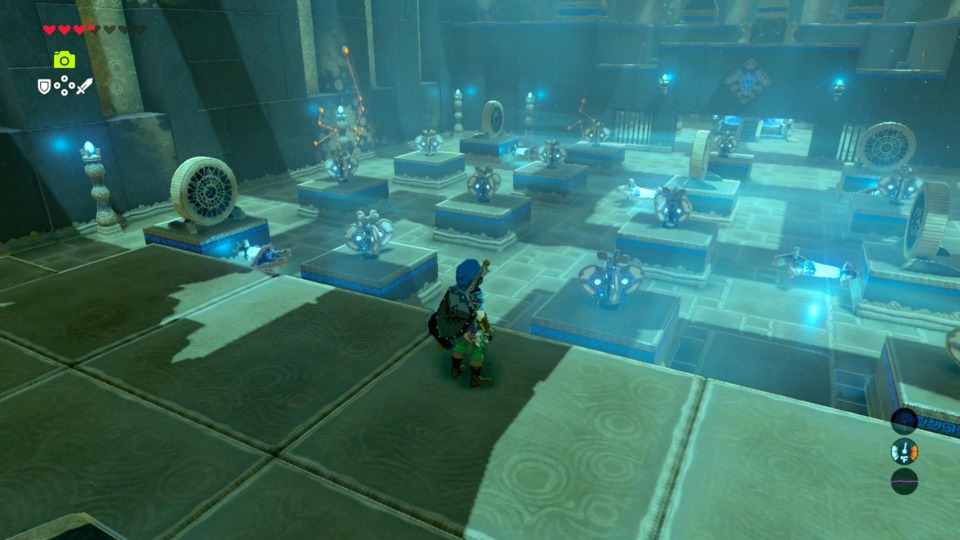
All of this is in service of exploring the vast world of Hyrule and it's many activities. The most important thing to find out in the world, are the shrines. Without the proper dungeons the series has been known for in the past, the more than one hundred shrines serve as the meat of the puzzles to be found in the game. Most involve using the abilities you gained at the beginning of the game such as creating bombs or using magnetism to move metal objects in order to solve small puzzles and reach the exit and get a spirit orb, which acts as a replacement for the heart pieces of old. Obtaining four spirit orbs allows you to pray at a shrine to cash them in to receive a new heart container, or increase your stamina gauge (which is what I heavily focused on at first). As well as the puzzle rooms, there are also some shrines that pose combat challenges, but there are quite a bit fewer of those. Nothing is quite as delightfully distracting as heading in one direction towards wherever you're going, only to have your shrine radar start to beep, letting you know there's another puzzle to be found somewhere nearby and immediately veering off course to find it.
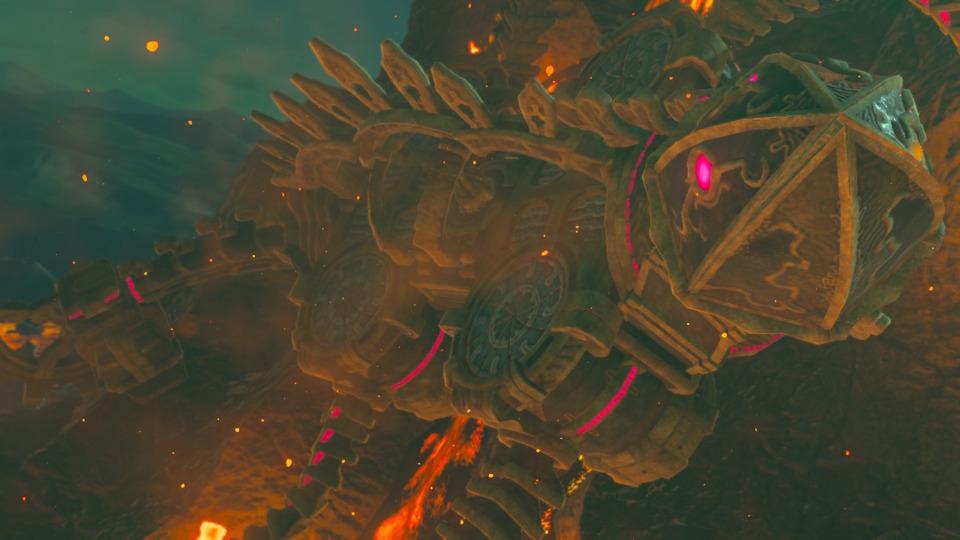
I mentioned that the traditional dungeons as you know them are absent. Instead the story revolves around Link freeing the four Divine Beasts - lumbering mechanical weapon-fortresses - from Ganon's influence so they can be used against him in the final battle. To do so requires Link to go inside of them and reactivate them so they can be controlled once more. While not nearly as time-consuming and expansive as the temples and dungeons of the past games, these Divine Beasts serve as their own series of connected rooms with puzzles in them leading to a boss fight that effectively make them the stand-in. There's no set order to doing any of them, either, as nearly every story beat in the game can be done in any combination you want, or skipped all together. You don't have to do the Divine Beasts, you don't really have to do anything after you leave the plateau, you can run right to Ganon's door and challenge the final boss. It would be significantly more difficult, but it can be done, and that's sort of fascinating. You would be denying yourself of all the game has to offer, but as a second, third, fourth playthrough, etc. it could be fun to keep challenging yourself to do less and less before trying to take on Ganon, adding a lot of optional replayability and self-imposed limiters.
The final significant changes of note come in the sound department. First of all, there's finally actual voice acting for important story scenes, usually found in the form of memories from Link's past scattered around the world. Link's still a mostly mute character (clearly a bridge too far for Nintendo just yet), but Zelda and the other principle characters - the champions sworn to each of the Divine Beasts from the recognizable franchise races like the Zora and Gorons - are all fully voiced in these scenes. There's not too much as far as voice acting as these scenes tend to be few and far between, but they are a welcome sign of growth to be built on. The other noticeable change is the lack of the sweeping, powerful score that has accompanied many of the Zelda games previously. While this may seem like a bummer as the music of Zelda is some of the most iconic in video games, full stop, it actually works here. Instead of the old style, there is a subtle, sometimes hard to notice music that pipes in at the right times, and disappears in favor of the sound of the world around you when needed. For a game that's full of bold choices and stuff to do at every turn, the music being simple and restrained feels like a wonderful counter-balance that never really let me down. Especially in the places it wisely chooses to use new instrumentation of old music for that nostalgic tug. There aren't very many of them, and that's what makes the ones that are there work so well.
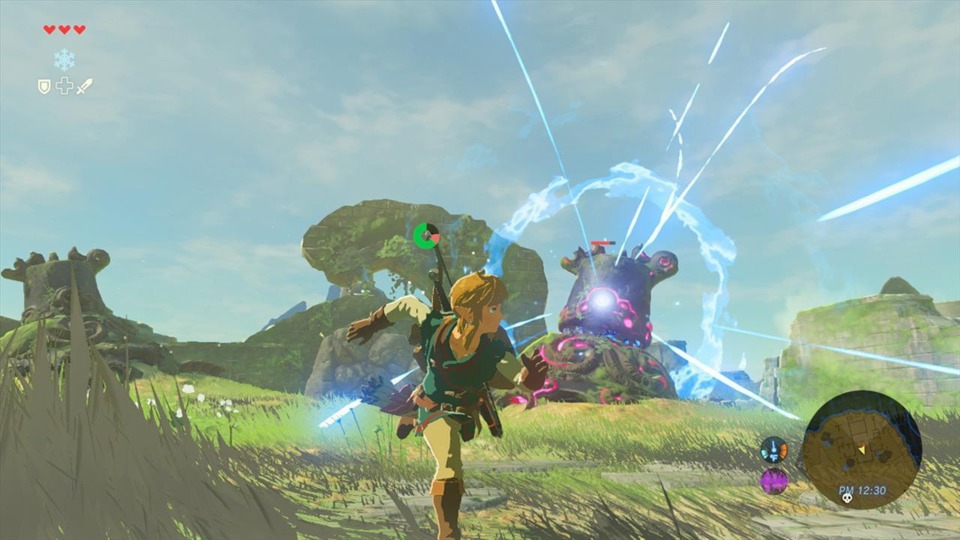
There are some things that could use a bit more refinement in future games. Not to say anything that didn't work is much of a deal-breaker, but there are a few issues worth mentioning. Cooking is a bit cumbersome and repetitive, as fun as it is to make new dishes and elixirs with different buffs for different occasions. Having to go into the menu and manually put each ingredient into Link's hands for him to toss into the pot is a little silly when you should just have a recipe list so you don't have to do that after you've made a dish for the first time and instead just use the materials you have to make as much as you want. Also, you can only cook at pots you find in the world, you never have one you can just plunk down on any fire you make in the wild. Not a big problem, but something to improve upon. The other famous point of contention is the rain, and to a lesser extent, the blood moons. When it rains, everything becomes slick and it's hard to climb without slipping off, and in a game where climbing can be the primary form of getting around, that can be a real annoyance. I'm not sure what the solution is, aside from maybe having gear that can negate most of the ill-effects or something, but being halfway up a mountain only to be stuck could be a little irksome. The blood moons, an occurrence every so often where the moon would glow red and enemies would repopulate and get more fierce, don't really have a solution other than to remove them. I honestly found it more bothersome than the rain sometimes, especially the couple of instances where I was in the middle of an encounter clearing out enemies around a tower so I could reveal more of the map, only for a blood moon to arrive and repopulate the area with the enemies I had already killed. Again these aren't big problems, I'm straining to even find problems, but they are things to hopefully fix going forward.
There's so much more to talk about, and yet, so little left I really feel like I need to say. I could go on and on about what makes Breath of the Wild so special, but I'd just be beating a dead horse at that point. The opening scene where Link wakes up and gets out of the tank he'd been sleeping in works on a meta level removed from the context of the story, because this truly is a rebirth for the Zelda franchise. Almost everything has been reworked and retooled into something amazing, and yet it is unmistakably Zelda. The spirit of what Zelda was - or perhaps was always supposed to be - is alive and well, and thriving in this new adventure. You could argue that Nintendo are maybe a little late to the party, as good open world games have existed for some time, but it was certainly worth the wait. Beautiful understated score, vibrant colours and art design, a huge open world full of interesting things to do, an actual story, this is the Zelda game that has everything. The standards have been raised, to an almost dangerous level for whatever game has to follow this one. This is the game that is the template for what comes next the way that Ocarina of Time was two decades ago, and I couldn't be more excited.
